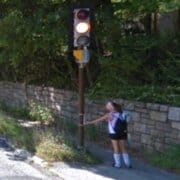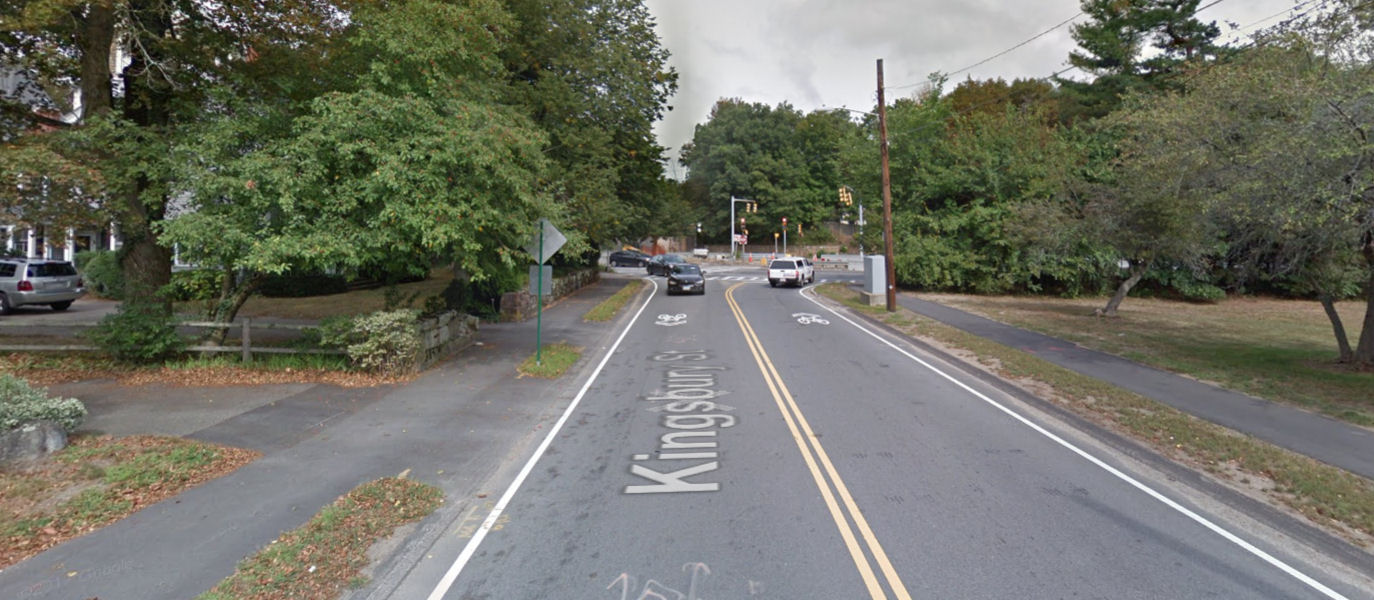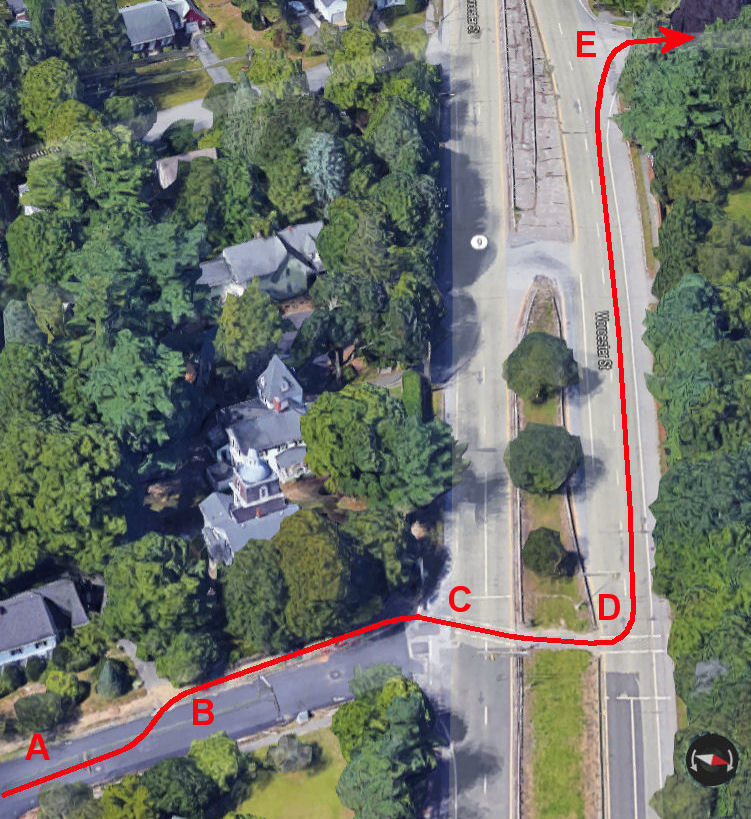When Sidewalk Riding Is Your Best Option
I’m not a great fan of riding on sidewalks. If I’m riding on anything located alongside a street, I slow way down, because I know I must be able to stop on a moment’s notice.
Sidewalk riding is sometimes exactly the right thing to do.
You may be surprised, then, when I say that sidewalk riding is sometimes exactly the right thing to do.
Let’s look at a specific location: Massachusetts Route 9 and Kingsbury Street in Wellesley, Massachusetts.
Route 9 is a four-lane divided highway with a 50 MPH speed limit. Quiet local streets on either side of Route 9 make some good connections for bicyclists.
Kingsbury Street T’s into Route 9 from the south. A signalized crosswalk across Route 9 connects with the sidewalk on the left side of Kingsbury Street. Push-buttons trigger the signal to stop traffic on Route 9.
Need to cross Route 9 with your bicycle?
Push the button, use the crosswalk. End of story. Right?
Whoa, no, wait a minute. Let’s think about this.
Savvy bicyclists plan ahead.
The best strategy is to use the left sidewalk to get up to the intersection, crossing Kingsbury Street well before reaching Route 9.
Yes, I just wrote that.
Why? Think about it. I want to use the pedestrian crosswalk there to get across Route 9.
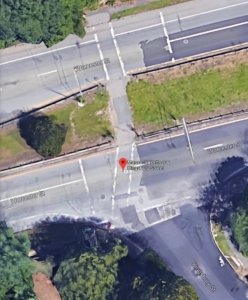
Don’t follow the on-road shared lane markings at this intersection. Easiest way to cross is to use “pedestrian” behavior
What could happen if I followed the shared lane markings in the photo and rode up almost to the corner on the right side of Kingsbury Street, and then cut across?
What if a motorist is turning right — like in the photo above — just as I want to move left to use the crosswalk cut-through? The driver coming around the corner might not see me making that maneuver until too late to avoid a collision.
Instead, I wait until there is no vehicle in front of me that might turn left into one of the last driveways before Kingsbury Street, then merge into one and ride on the sidewalk up to the corner.
I’m cognizant of being on a sidewalk, so I ride slowly enough to see into the other driveways that cross this sidewalk, no problem.
When I get to the corner, sometimes a car will have triggered the traffic signal. If not, I push the button and cross after the traffic signal changes.
The picture above shows my path:
- On Kingsbury Street headed for Route 9
- Using one of the driveways to get onto my preferred sidewalk
- Pushing the button on the corner and waiting for the signal to change
- Turning left onto Route 9’s right traffic lane
- Turning right onto Sprague Road
Because I’m riding off of a sidewalk
and entering the intersection from an unusual location, I’m careful to wait until all traffic has stopped. Since Route 9 is a divided highway, I can roll across to the median without concern that a motorist behind me might cut a left turn across my path.
When I get to the other side of Route 9, I turn left and ride on the road a short distance to turn right onto Sprague Road.
Wait a minute. Why does the illustration show me riding in the travel lane on high-speed Route 9? Why would I do that? There’s a wide, paved shoulder!
Well, yes, riding on the shoulder would be nice, but isn’t always possible. Have a look at the next image, a Google Street View:
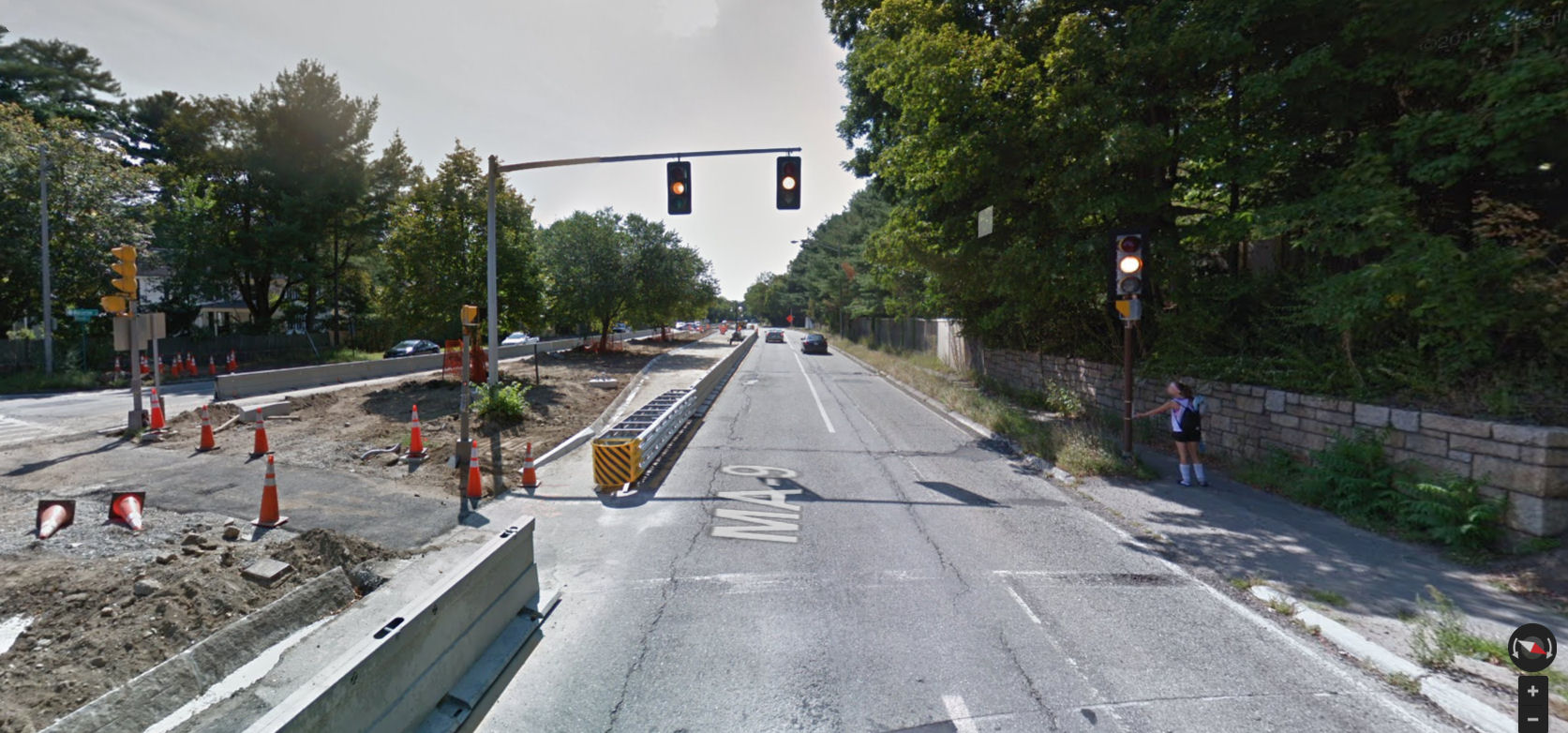
Child activates traffic signals. Shoulder of Route 9 is in use as a travel lane due to construction (Wellesley, MA)
We are looking west along Route 9 from location D in the earlier image, with location E in the background. A child with a backpack is pushing the button to turn the traffic signal red and use the crosswalk. That isn’t surprising. There’s a public school on Kingsbury Street.
But in the photo, construction work is underway and the shoulder of Route 9 is serving temporarily as a travel lane. You can’t always count on an empty shoulder’s being available, whether because of construction, snow in winter, a disabled vehicle, or a state trooper issuing a traffic ticket to a wayward Massachusetts driver.
So, yes, I’m going to enter from a crosswalk and immediately turn left into the right travel lane on a highway with a 50 MPH speed limit. Scary? Not!
Confession time
For decades, I’ve worked as a bicycle safety and crash reconstruction expert. I wrote Bicycling Street Smarts, which has been published in several editions and sold more than 300,000 copies.
Even experts learn new things.
Even experts learn new things. I learned the following incredibly useful technique only last year, when I became a CyclingSavvy Instructor (that story is here).
What technique is that? Using traffic-signal timing to get a busy road to yourself.
In this case, it’s easy to move onto Route 9 from the Kingsbury pedestrian crosswalk when Route 9 traffic is stopped at the light.
I have Route 9 all to myself all the way to Sprague Road!
Using traffic signal timing to ride on “scary” roads with little to no other traffic was a revelation. (Yes, this technique is now included in the CyclingSavvy edition of Bicycling Street Smarts.)
How to cross Route 9 in the opposite direction
The most favorable route enters at Audubon Road, which Ts into Route 9 without a traffic signal or crosswalk. The image below shows the route. You ride on Route 9 from Audubon Road to Kingsbury Street, and cross there. You could ride on the shoulder (if available) and pull onto the sidewalk to push the crosswalk button.
If the shoulder’s available, riding on it is fast and easy. If there’s absolutely no traffic on the road, you might move from Audubon directly into the left lane to get easily onto the crosswalk at Kingsbury.
Don’t do this if there’s any other traffic on the road. Traffic signals won’t help. The previous traffic signal is more than a mile back, and platoons of traffic spread out and mix together. It’s hard to judge the closing speeds of fast-moving traffic (and you don’t want to get caught up in that).
If the shoulder isn’t available, use the sidewalk.
Yes, you read that right. A quick exploration of Route 9 in Google Street View reveals that there are exactly zero driveways on the north side of Route 9 between Audubon Road and Kingsbury Street.
When planning your next bike trip or adventure, Google Maps and Google Street View are your best friends.
Instead, a long, high fence gives residents relief from the unpleasantness of Route 9 — and offers bicyclists a first-rate opportunity to ride safely on a sidewalk. Just take care around any schoolchildren or others who may be sharing the sidewalk with you.
Now that we’ve looked at both directions of travel across Route 9, let these be your takeaways:
- Riding in sidewalk space is unsafe where there are hazards with turning and crossing traffic, obscured sight lines and unpredictable pedestrians.
- Even so, sidewalk riding can be useful. Remember that when you’re in pedestrian space, use pedestrian behavior.
- Smart use of traffic-signal timing can empty a busy street for you.
- Planning ahead makes it easy to get through segments which at first appear challenging and even intimidating, because:
- Google Maps and Google Street View are your best friends for armchair pre-planning.
Happy savvy cycling, wherever you ride.

